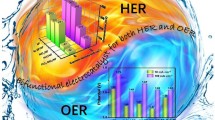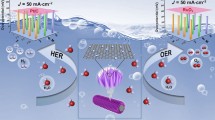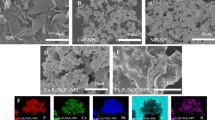Abstract
Composition adjustment and establishment of multifunctional sites are promising routes to enhance the performance of Pt nanoalloys. A new strategy, involving surface controllable anchoring of Cu on nanostructured PtNi (named as Cu/PtNi), has been developed to enable precise control of stoichiometric elements. The nanostructured material contains oxophilic Ni that promotes fast water dissociation, Pt for superior H adsorption and efficient H2 production, and Cu to give positive Gibbs free-energy of active hydrogen adsorption for H2 desorption. The new Cu/PtNi electrocatalyst displays superior activity in the electrocatalytic hydrogen evolution reaction, associated with an overpotential of 23 mV at 10 mA cm−2 in alkaline seawater that is five times higher than the mass activity of commercial Pt/C (at 70 mV overpotential). Results of density functional theory calculations verify that key processes including H2O dissociation, H* adsorption and H2 desorption involved in the hydrogen evolution reaction pathway in alkaline seawater are facilitated by Pt, Ni, and Cu multifunctional metal sites.

摘要
表面组分调控及建立多功能活性位点是提高Pt基催化剂性能的有效途径. 通过将Cu可控地锚定在纳米结构PtNi表面(Cu/PtNi)可以精确控制Pt基催化剂表面元素的化学计量比, 其中亲氧的非贵金属Ni能加速水的解离, Pt由于具有适中的H吸附能, 可有效地将游离态的H转换成氢气, Cu由于具有正的H吸附吉布斯自由能(ΔGH*), 有助于H2的脱附. 其中具有最优组分比例的Cu/PtNi电催化剂在海水中表现出优异的电化学析氢活性和稳定性, 在碱性海水中, 10 mA cm−2下的过电位为23 mV (在70 mV过电位下, 其质量活性是商用Pt/C的5倍). 同时, 密度泛函理论结果进一步验证了在碱性海水中Pt, Ni和Cu多功能金属活性位点可提高HER的H2O解离、 H*吸附和H2脱附的过程.
Similar content being viewed by others
References
Panda C, Menezes PW, Yao S, et al. Boosting electrocatalytic hydrogen evolution activity with a NiPt3@NiS heteronanostructure evolved from a molecular nickel-platinum precursor. J Am Chem Soc, 2019, 141: 13306–13310
Greeley J, Jaramillo TF, Bonde J, et al. Computational high-throughput screening of electrocatalytic materials for hydrogen evolution. Nat Mater, 2006, 5: 909–913
Zeradjanin AR, Grote JP, Polymeros G, et al. A critical review on hydrogen evolution electrocatalysis: Re-exploring the volcano-relationship. Electroanalysis, 2016, 28: 2256–2269
Cheng X, Li Y, Zheng L, et al. Highly active, stable oxidized platinum clusters as electrocatalysts for the hydrogen evolution reaction. Energy Environ Sci, 2017, 10: 2450–2458
Xie Y, Cai J, Wu Y, et al. Boosting water dissociation kinetics on Pt-Ni nanowires by N-induced orbital tuning. Adv Mater, 2019, 31: 1807780
Wang P, Zhang X, Zhang J, et al. Precise tuning in platinum-nickel/ nickel sulfide interface nanowires for synergistic hydrogen evolution catalysis. Nat Commun, 2017, 8: 14580
Chen C, Kang Y, Huo Z, et al. Highly crystalline multimetallic nanoframes with three-dimensional electrocatalytic surfaces. Science, 2014, 343: 1339–1343
Jang SW, Dutta S, Kumar A, et al. Holey Pt nanosheets on NiFe-hydroxide laminates: Synergistically enhanced electrocatalytic 2D interface toward hydrogen evolution reaction. ACS Nano, 2020, 14: 10578–10588
Wang X, Zheng Y, Sheng W, et al. Strategies for design of electrocatalysts for hydrogen evolution under alkaline conditions. Mater Today, 2020, 36: 125–138
Kepp KP. A quantitative scale of oxophilicity and thiophilicity. Inorg Chem, 2016, 55: 9461–9470
Zhang XQ, Xiao YX, Tian G, et al. Enhancing resistance to chloride corrosion by controlling the morphologies of PtNi electrocatalysts for alkaline seawater hydrogen evolution. Chem Eur J, 2023, 29: e202202811
Xiao YX, Ying J, Tian G, et al. Hierarchically fractal PtPdCu sponges and their directed mass- and electron-transfer effects. Nano Lett, 2021, 21: 7870–7878
Xiao ST, Wu SM, Dong Y, et al. Rich surface hydroxyl design for nanostructured TiO2 and its hole-trapping effect. Chem Eng J, 2020, 400: 125909
Elgrishi N, McCarthy BD, Rountree ES, et al. Reaction pathways of hydrogen-evolving electrocatalysts: Electrochemical and spectroscopic studies of proton-coupled electron transfer processes. ACS Catal, 2016, 6: 3644–3659
Wu SM, Rosei F, Yang XY. Coupling rules for bifunctional pair sites. Matter, 2023, 6: 13–15
Wu SM, Beller M, Yang XY. A clear view of zeolite-catalyzed processes. Matter, 2022, 5: 3104–3107
Wu SM, Čejka J, Yang XY. Active sites in the right places. Nat Synth, 2022, 1: 757–758
Xiao ST, Yin R, Wu L, et al. Hierarchically porous few-layer carbon nitride and its high H+ selectivity for efficient photocatalytic seawater splitting. Nano Lett, 2023, 23: 4390–4398
Chen Y, Wang Y, Yu J, et al. Underfocus laser induced Ni nanoparticles embedded metallic MoN microrods as patterned electrode for efficient overall water splitting. Adv Sci, 2022, 9: 2105869
Yu J, Wang A, Yu W, et al. Tailoring the ruthenium reactive sites on N doped molybdenum carbide nanosheets via the anti-Ostwald ripening as efficient electrocatalyst for hydrogen evolution reaction in alkaline media. Appl Catal B-Environ, 2020, 277: 119236
Yu Q, Yu W, Wang Y, et al. Hydroxyapatite-derived heterogeneous Ru-Ru2P electrocatalyst and environmentally-friendly membrane electrode toward efficient alkaline electrolyzer. Small, 2023, 19: 2208045
Wang K, Cao J, Yang X, et al. Kinetically accelerating elementary steps via bridged Ru-H state for the hydrogen-evolution in anion-exchange membrane electrolyzer. Adv Funct Mater, 2023, 33: 2212321
Wang K, Wang Y, Yang B, et al. Highly active ruthenium sites stabilized by modulating electron-feeding for sustainable acidic oxygen-evolution electrocatalysis. Energy Environ Sci, 2022, 15: 2356–2365
Cheng F, Peng X, Hu L, et al. Accelerated water activation and stabilized metal-organic framework via constructing triangular active-regions for ampere-level current density hydrogen production. Nat Commun, 2022, 13: 6486
Dai Q, Wang L, Wang K, et al. Accelerated water dissociation kinetics by electron-enriched cobalt sites for efficient alkaline hydrogen evolution. Adv Funct Mater, 2022, 32: 2109556
Wang L, Li Z, Wang K, et al. Tuning d-band center of tungsten carbide via Mo doping for efficient hydrogen evolution and Zn-H2O cell over a wide pH range. Nano Energy, 2020, 74: 104850
Feng G, Ning F, Song J, et al. Sub-2 nm ultrasmall high-entropy alloy nanoparticles for extremely superior electrocatalytic hydrogen evolution. J Am Chem Soc, 2021, 143: 17117–17127
Dinh CT, Jain A, de Arquer FPG, et al. Multi-site electrocatalysts for hydrogen evolution in neutral media by destabilization of water molecules. Nat Energy, 2018, 4: 107–114
Ying J, Symes MD, Yang XY. Directional transport for efficient catalysis. Matter, 2023, 6: 674–676
Dong Y, Li J, Yang XY. Cu catalysts detour hydrogen evolution reaction. Matter, 2022, 5: 2537–2540
Yu ZY, Duan Y, Feng XY, et al. Clean and affordable hydrogen fuel from alkaline water splitting: Past, recent progress, and future prospects. Adv Mater, 2021, 33: e2007100
Wu X, Zhou S, Wang Z, et al. Engineering multifunctional collaborative catalytic interface enabling efficient hydrogen evolution in all pH range and seawater. Adv Energy Mater, 2019, 9: 1901333
Jin H, Wang X, Tang C, et al. Stable and highly efficient hydrogen evolution from seawater enabled by an unsaturated nickel surface nitride. Adv Mater, 2021, 33: 2007508
Ma YY, Wu CX, Feng XJ, et al. Highly efficient hydrogen evolution from seawater by a low-cost and stable CoMoP@C electrocatalyst superior to Pt/C. Energy Environ Sci, 2017, 10: 788–798
Zhu J, Hu L, Zhao P, et al. Recent advances in electrocatalytic hydrogen evolution using nanoparticles. Chem Rev, 2020, 120: 851–918
Shen L, Ying J, Ozoemena KI, et al. Confinement effects in individual carbon encapsulated nonprecious metal-based electrocatalysts. Adv Funct Mater, 2022, 32: 2110851
Pu FF, Xiao YX, Yang X, et al. Semiconductors modified gourd-shaped hollow PtNi and their directional electron and mass transfer effects. Chem Eng J, 2023, 474: 145630
Jin H, Liu X, Vasileff A, et al. Single-crystal nitrogen-rich two-dimensional Mo5N6 nanosheets for efficient and stable seawater splitting. ACS Nano, 2018, 12: 12761–12769
Kuang Y, Kenney MJ, Meng Y, et al. Solar-driven, highly sustained splitting of seawater into hydrogen and oxygen fuels. Proc Natl Acad Sci USA, 2019, 116: 6624–6629
Cao Z, Chen Q, Zhang J, et al. Platinum-nickel alloy excavated nanomultipods with hexagonal close-packed structure and superior activity towards hydrogen evolution reaction. Nat Commun, 2017, 8: 15131
Cao Z, Li H, Zhan C, et al. Monocrystalline platinum-nickel branched nanocages with enhanced catalytic performance towards the hydrogen evolution reaction. Nanoscale, 2018, 10: 5072–5077
Ma H, Zheng Z, Zhao H, et al. Trimetallic PtNiCo branched nanocages as efficient and durable bifunctional electrocatalysts towards oxygen reduction and methanol oxidation reactions. J Mater Chem A, 2021, 9: 23444–23450
Cui W, An W, Liu L, et al. Novel Cu2O quantum dots coupled flower-like BiOBr for enhanced photocatalytic degradation of organic contaminant. J Hazard Mater, 2014, 280: 417–427
Xiao YX, Ying J, Tian G, et al. PtPd hollow nanocubes with enhanced alloy effect and active facets for efficient methanol oxidation reaction. Chem Commun, 2021, 57: 986–989
Wang K, Du H, Sriphathoorat R, et al. Vertex-type engineering of Pt-Cu-Rh heterogeneous nanocages for highly efficient ethanol electro-oxidation. Adv Mater, 2018, 30: 1804074
Xiao YX, Ying J, Tian G, et al. Highly dispersed PtPd on graphitic nanofibers and its heavy d-π effect. Appl Catal B-Environ, 2019, 259: 118080
Xin H, Holewinski A, Schweitzer N, et al. Electronic structure engineering in heterogeneous catalysis: Identifying novel alloy catalysts based on rapid screening for materials with desired electronic properties. Top Catal, 2012, 55: 376–390
Liu H, Ye F, Yao Q, et al. Stellated Ag-Pt bimetallic nanoparticles: An effective platform for catalytic activity tuning. Sci Rep, 2014, 4: 3969
Dai S, Chou JP, Wang KW, et al. Platinum-trimer decorated cobalt-palladium core-shell nanocatalyst with promising performance for oxygen reduction reaction. Nat Commun, 2019, 10: 440
He D, Zhang L, He D, et al. Amorphous nickel boride membrane on a platinum-nickel alloy surface for enhanced oxygen reduction reaction. Nat Commun, 2016, 7: 12362
Pu Z, Amiinu IS, Kou Z, et al. RuP2-based catalysts with platinum-like activity and higher durability for the hydrogen evolution reaction at all pH values. Angew Chem Int Ed, 2017, 56: 11559–11564
Seh ZW, Kibsgaard J, Dickens CF, et al. Combining theory and experiment in electrocatalysis: Insights into materials design. Science, 2017, 355: eaad4998
Xiao YX, Ying J, Chen JB, et al. Confined ultrafine Pt in porous carbon fibers and their N-enhanced heavy d-π effect. Chem Mater, 2022, 34: 3705–3714
Xu J, Liu T, Li J, et al. Boosting the hydrogen evolution performance of ruthenium clusters through synergistic coupling with cobalt phosphide. Energy Environ Sci, 2018, 11: 1819–1827
Hu J, Zhang C, Jiang L, et al. Nanohybridization of MoS2 with layered double hydroxides efficiently synergizes the hydrogen evolution in alkaline media. Joule, 2017, 1: 383–393
Zhang Z, Liu G, Cui X, et al. Crystal phase and architecture engineering of lotus-thalamus-shaped Pt-Ni anisotropic superstructures for highly efficient electrochemical hydrogen evolution. Adv Mater, 2018, 30: 1801741
Xiao YX, Ying J, Liu HW, et al. Pt–C interactions in carbon-supported Pt-based electrocatalysts. Front Chem Sci Eng, 2023, 17
Zhang J, Wang T, Liu P, et al. Efficient hydrogen production on MoNi4 electrocatalysts with fast water dissociation kinetics. Nat Commun, 2017, 8: 15437
Zheng Y, Jiao Y, Jaroniec M, et al. Advancing the electrochemistry of the hydrogen-evolution reaction through combining experiment and theory. Angew Chem Int Ed, 2015, 54: 52–65
Kitchin JR, Nørskov JK, Barteau MA, et al. Role of strain and ligand effects in the modification of the electronic and chemical properties of bimetallic surfaces. Phys Rev Lett, 2004, 93: 156801
Shen LW, Wang Y, Chen JB, et al. A RuCoBO nanocomposite for highly efficient and stable electrocatalytic seawater splitting. Nano Lett, 2023, 23: 1052–1060
Chen J, Ying J, Xiao Y, et al. Stoichiometry design in hierarchical CoNiFe phosphide for highly efficient water oxidation. Sci China Mater, 2022, 65: 2685–2693
Acknowledgements
This work was supported by the National Key Research and Development Program of China (2022YFB3805600, 2022YFB3805604, and 2022YFB3806800), the National Natural Science Foundation of China (22293020), the National 111 project (B20002), the Program Fund of Non-Metallic Excellence and Innovation Center for Building Materials (2023TDA1-1), the Program for Changjiang Scholars and Innovative Research Team in University (PCSIRT) (IRT_15R52), Guangdong Basic and Applied Basic Research Foundation (2022A1515010137, 2022A1515010504, and 2021A1515111131), Shenzhen Science and Technology Program (GJHZ20210705143204014, JCYJ20210324142010029, and KCXFZ20211020170006010), Hubei Province Key Research and Development Program (2023BAB101), and the Fundamental Research Funds for the Central Universities (WUT: 2023IVA095 and 2023IV030h). We thank the Nanostructure Research Centre (NRC) for performing the S/TEM imaging. Mark D. Symes thanks the Royal Society for a University Research Fellowship (UF150104, URFR211007).
Author information
Authors and Affiliations
Contributions
Author contributions Yang X performed the experiments related to the synthesis and electrocatalytic performance. Yang X, Xiao YX, and Yang XY conceived the project, provided the ideas and designed the experiments. Tian G performed TEM and EDX characterizations. Chen JB and Yu F performed DFT calculation and analysis. Pu FF provided guidance for material synthesis. Yang X, Xiao YX, and Yang XY wrote and revised the paper. de Torresi SIC, Symes MD, Zhang S, and Janiak C revised the paper. All the authors discussed the results, analyzed the data, and gave their approval for the submission of the final version of the manuscript.
Corresponding author
Ethics declarations
Conflict of interest The authors declare that they have no conflict of interest.
Additional information
Xiong Yang received his Bachelor degree in materials science from Wuhan University of Technology in 2019. He is currently a PhD candidate under the supervision of Prof. Xiaoyu Yang at Wuhan University of Technology. His research interest focuses on Pt-based metal compounds for applications in the electrocatalysis field.
Yu-Xuan Xiao received his PhD degree from Wuhan University of Technology in 2021. Currently, he is a postdoctoral fellow at Sun Yat-sen University. His research interest is focused on the design and synthesis of metal nanomaterials, as well as their applications in electrocatalysis.
Xiao-Yu Yang earned his BS degree from Jilin University in 2000 and his joint PhD degree from Jilin University, China and Facultes Universitaires Notre-Dame de la Paix (FUNDP), Belgium (co-education) in 2007. After a post-doctoral fellowship at FUNDP, he worked as a “Chargé de Recherches” at Le Fonds de la Recherche Scientifique (F.N. R.S.) of Belgium. He is currently working as a full professor at the State Key Laboratory of Advanced Technology for Material Synthesis and Processing and a visiting professor at Harvard University.
Supplementary information Experimental details and supporting data are available in the online version of the paper.
Supporting Information
40843_2023_2566_MOESM1_ESM.pdf
Surface controllable anchoring of Cu onto nanostructured PtNi for efficient electrochemical hydrogen evolution from seawater
Rights and permissions
About this article
Cite this article
Yang, X., Xiao, YX., Chen, JB. et al. Surface controllable anchoring of Cu onto nanostructured PtNi for efficient electrochemical hydrogen evolution from seawater. Sci. China Mater. 66, 3887–3894 (2023). https://doi.org/10.1007/s40843-023-2566-y
Received:
Accepted:
Published:
Issue Date:
DOI: https://doi.org/10.1007/s40843-023-2566-y




